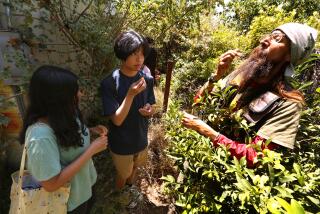All Math and No Play Brings Change in Curriculum at Special Academy : Education: In its second year, school meets student concerns by offering more sports and social activities.
- Share via
When the California Academy of Mathematics and Science opened on the campus of Cal State Dominguez Hills last year, the first class of students entered the prestigious specialized high school with mixed feelings.
Although some were proud of being accepted by an unusual high school with an advanced curriculum, many of the freshmen worried that they would be missing out socially because the academy offered few extracurricular activities and competitive sports.
But when the school opened for its second year, students had fewer worries about their social lives. In addition to course work in areas such as advanced anatomy and biochemistry, the academy offers drama, a student magazine and chorus, as well as sports including track, water polo and swimming.
“Last year, when the students came in, they were excited but also a little nervous because this was so different from other schools. They felt they would miss all of the activities at the other high schools,” said John Hollick, student body adviser. “This year (because of the new activities) they feel a sense of identity with the school, a sense of loyalty.”
The academy, a public high school offering a math- and science-based curriculum, opened last year to critical acclaim. Targeting mostly females and ethnic minorities, the school aims to help those students enter technological fields where they have been underrepresented. It is operated by a consortium of eight school districts, including Long Beach Unified and Compton Unified. The other districts are Los Angeles Unified, Torrance Unified, Hawthorne, Inglewood Unified, Lawndale and Palos Verdes Peninsula Unified.
With the addition of this year’s freshman class, the school’s enrollment has grown from 117 to 247. The student body is 28% black, 28% Latino, 14% Anglo and 29% Asian and other minorities.
Investors in the program, including Hughes Aircraft, Nissan Motor and Shell Oil, have donated more than $2 million. IBM, Apple Computer and Digital Equipment Corp. donated thousands of dollars in high-tech equipment.
Last year, one of the few activities for the youths was a student council that included at least one representative from each of the school’s eight homerooms. When the group met with the faculty to discuss student needs, a primary issue was extracurricular activities and sports.
“Students were concerned that their social needs weren’t being met,” Hollick said.
After months of meetings, students and faculty members planned a diverse program of extracurricular activities and sports. There are also a number of student clubs and a student-operated store.
“We see these students studying in the labs and doing advanced study, but sometimes we forget, even though they don’t, that these are just 14-year-olds,” said Doug Stewart, director of development and external affairs. “Students have taken full advantage of the activities, and there is certainly no lack of school spirit.”
That sense of school spirit seems to permeate the atmosphere at the school, which is housed in two modular units at the south end of the Cal State Dominguez Hills campus. Colorful posters announcing new clubs and activities dot the hallways, and students stop between classes to chat with each other.
“Last year we didn’t have time to be social because the student council was just getting (on) its feet,” said Redza Ibrahim, 15. “Now we have a ninth and 10th grade, so there are more people and we are a lot more social.”
So far this year, there has been a back-to-school party and a Halloween costume party. A semiformal Christmas dance is planned.
“The kids support everything here to a high degree and really make it go,” Hollick said. “They are above average as far as (academic) abilities are concerned, but they have the same social needs to be met.”
The academy selects up to four students a year from 60 schools in the eight surrounding districts. Students are chosen on the basis of application information, grades and personal interviews. Students must have scored in the top 30% in math on their district’s standardized tests.
The students take rigorous courses including biochemistry, astronomy and computer programming in their freshman year. Other challenging classes, such as anatomy and environmental law, are added in the sophomore year.
With such a demanding program, many students are enthusiastic about the new social activities.
“We miss the upperclassmen to push us around and interscholastic competition because a lot of my friends (in other schools) are having fun on the football team,” sophomore Dan Lyons said. “But the things that we gain outweigh the things we lose.”
More to Read
Sign up for Essential California
The most important California stories and recommendations in your inbox every morning.
You may occasionally receive promotional content from the Los Angeles Times.










